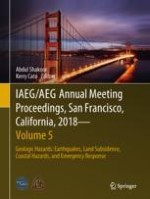
2019 | OriginalPaper | Buchkapitel
Surface Rupture Hazard Zonation: Lessons from Recent New Zealand Earthquakes
verfasst von : Clark Fenton, Natalie Hyland, Blake Hoare
Erschienen in: IAEG/AEG Annual Meeting Proceedings, San Francisco, California, 2018 - Volume 5
Aktivieren Sie unsere intelligente Suche, um passende Fachinhalte oder Patente zu finden.
Wählen Sie Textabschnitte aus um mit Künstlicher Intelligenz passenden Patente zu finden. powered by
Markieren Sie Textabschnitte, um KI-gestützt weitere passende Inhalte zu finden. powered by